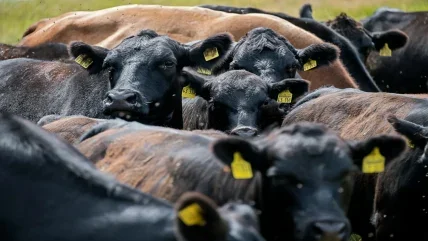
Warble flies are hairy and resemble small bumble bees with a band of dark hairs and then yellow-orange hairs on the abdomen. Hypoderma bovis is the larger of the two at approximately 1.5cm long. Hypoderma lineatum is slightly smaller. They may look cute and furry – but they are far from it. Their life-cycle makes rather gruesome reading and they cause immense distress to cattle with financial implications for farmers, butchers and tanners.
Warble flies lay their eggs on the legs of the animal in the summer months during which the females terrorise the cattle causing them to jump and run about. Sometimes cattle are so frightened they injure themselves trying to escape the flies and will even take refuge in water.
One female fly may lay up to 100 eggs on one animal. About four days later the eggs hatch and the larvae penetrate the skin of the legs into the connective tissue between the skin and muscle from where they begin their journey.
The larvae slowly eat their way upwards through the legs of the animal getting bigger as they go. Eventually the larvae reach the oesophagus or the spinal canal where they lay dormant for the winter. In early spring the larvae migrate to the back of the animal where they form a swelling under the skin.
After a while, the swelling develops a small hole through which the larva breathes. Here they lay for about a month growing bigger until they measure almost 3cm long.
Eventually, the mature larva crawls out through the breathing hole and falls to the ground where it buries itself and pupates. After around 35 days the pupae hatch into flies and the cycle begins over again.
Apart from the welfare of the animal, warble fly infestation creates financial problems for all concerned. Affected cattle often have reduced meat and milk yields and the farmer may be faced with veterinary bills to treat injuries. The meat industry is affected because infestation can cause downgrading of the carcass due to discolouration of the meat where the larvae have burrowed their way through the animal.
But probably it is the leather industry that is affected most since the holes that the warble grubs produce in the prime area of the hide render it almost useless. To put it into perspective, forty years ago there was a staggering estimate of four million cases of warble fly infestation in the UK – that was a huge loss of good quality hides.
In the UK attempts were made prior to the 1930s to eradicate the warble fly by introducing the Warble Fly Order that insisted that farmers treated all infected cattle. But due to a lack of resources and the ineffectual treatments available, the order was revoked in 19643.
In the 1970s a new breed of treatments were developed; organophosphorus insecticides. These products gave real hope of having a serious impact on the Warble Fly. With the help of the State Veterinary Service, the Meat & Livestock Commission and the Hide & Allied Trade Improvement Society, the Ministry for Agriculture, Fisheries and Food (MAFF) launched a campaign in 1978. Farmers were encouraged to provide cattle at risk of infestation with precautionary treatments and treatment of confirmed infestations were compulsory. The movement of affected animals was also restricted.
The effect of this campaign was astonishing; in ten years the incidence of warble fly infestation in the UK fell from four million to just four. It was considered to have been totally eradicated in the UK by 1990. As a consequence, the compulsory treatment of cattle was lifted.
Today, the only compulsory treatments in the UK are on imported cattle that have to be treated within 24 hours of arrival and any cattle showing evidence of infestation are returned to their country of origin. One of the knock-on effects of this compulsory treatment of cattle was that other ectoparasites, such as lice and ticks, were also controlled. Consequently, hide quality improved in many aspects, not just due to the lack of warble holes.
Since the lifting of the treatment order, there has been a noticeable increase in the amount of other parasite damage, light spot, which is caused by lice, in particular. So, whilst the warble fly campaign has been a resounding success story in the UK, it has in some respects become a victim of its own success.
Summary
Warble flies caused significant damage to hides in the UK until various organisations launched an eradication programme. This proved so successful that the species is now considered virtually extinct in the UK. But, since the lifting of the compulsory treatment programme, hide damage due to other ectoparasites has increased.






